#Dungeon Floor Modules
Photo
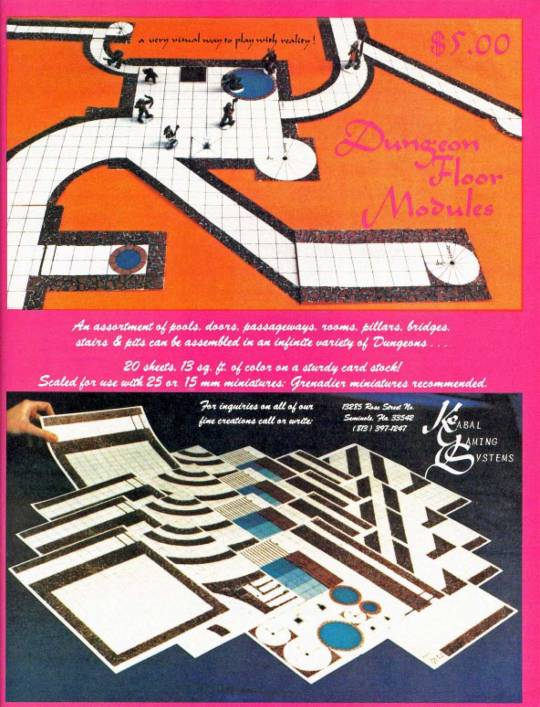
Dungeon Floor Modules by Kabal Gaming Systems, $5.00 for 20 cardstock sheets, 13 sq ft total area -- “A very visual way to play with reality! An assortment of pools, doors, passageways, rooms, pillars, bridges, stairs & pits can be assembled in an infinite variety of Dungeons . . .” Most of these rooms have a plain white gridded map with a stone texture border, unlike most other dungeon tiles with stone patterns on the floors (ad in Dragon 72, April 1983)
#D&D#Dungeons & Dragons#Kabal Gaming Systems#dungeon tiles#dungeon map#Dragon magazine#dnd#Dungeon Floor Modules#dungeon#geomorphs#Kabal#1980s#Dungeons and Dragons
254 notes
·
View notes
Text

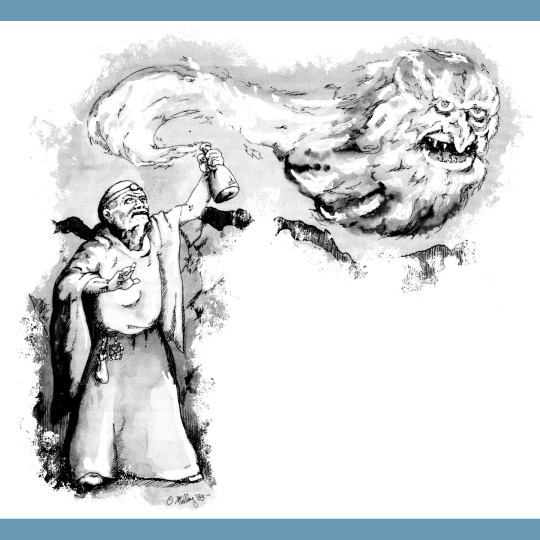

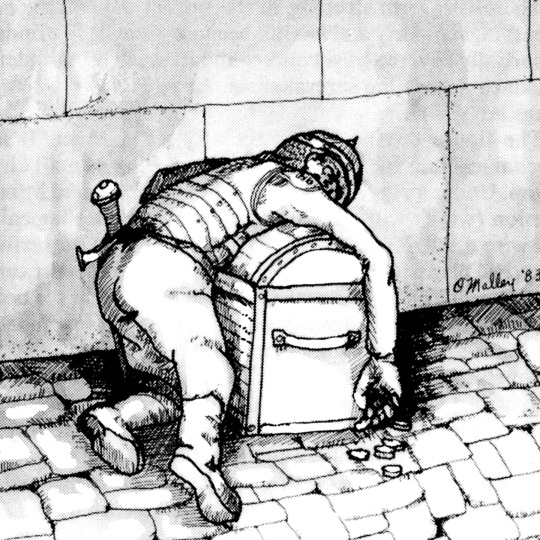
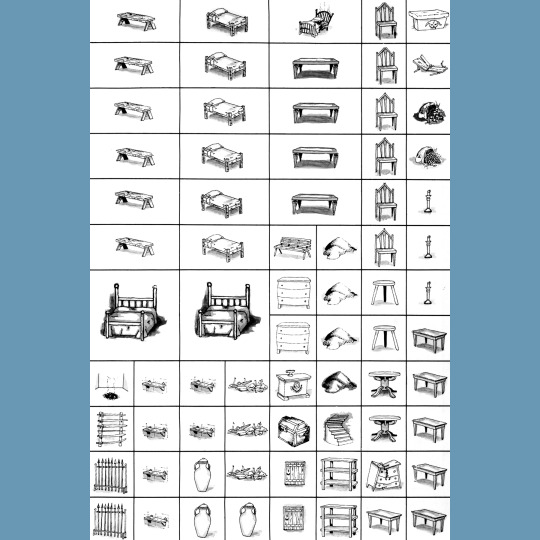
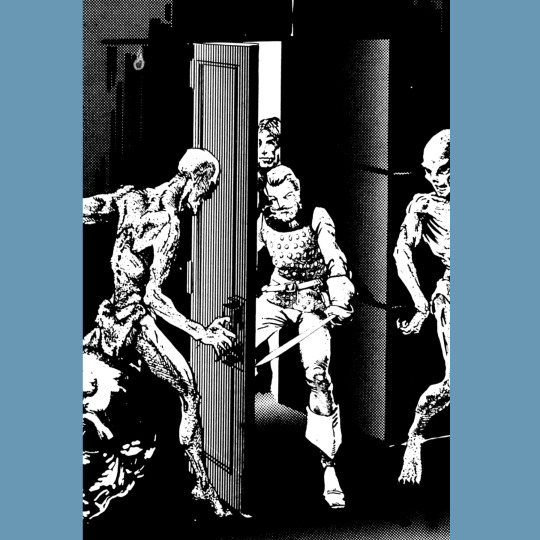
Tower of Magics (1983) is a sequel to the original Role Aids adventure, Beastmaker Mountain. That scenario involves Orlow the Beastmaker and his evil wife Frantasy. What a name. Frantasy. Anyway, as with Question of Gravity, the plot frame and macguffins are pretty secondary to the titular, puzzlebox location.
That tower is very…regular. It’s three floors. Each has a central stair case ringed by rooms. That ring is surrounded by a hallway and then the outer wall of the tower is riddled with more rooms. All the rooms are 6 meters square and 15 feet in height (really, really hate the mix of measurement systems); a grid and a set of tiles is provided for GMs to layout the room contents according to a key in the description. The tiles aren’t anything fancy — greyscale paper that needs to be pasted to cardboard and then cut out — but I can’t think of an adventure that includes them before this point (there were dedicated tile products, like Task Force’s Dungeon Tiles, and TSR would start getting in on the action with tile and standee-models in 1984).
The contents of the rooms are OK, more utilitarian than exciting, despite the subtitle describing the tower as a place “where magic has gone wild.” This was a tournament module and there is a central riddle with a correct answer to puzzle out, and the rooms conform to those needs rather than, like, rational building use. The monsters are a variety of undead, demons and evil humanoids, which is a sensible mix. The idea of these critters occupying and despoiling a once-noble edifice does a lot to counter the punishing weirdness of all the rooms being the same sized square.
89 notes
·
View notes
Text
Pre-G1 Modules, part 1 - Temple of the Frog

So we're going to blow through this really fast cus there's a lot to cover -- I have 9 modules to go through before we hit G1.
G1 enjoys the reputation of "first DND module", but the reality is a little more complicated than that. G1 is more properly, "The first published standalone TSR adventure module". Which, as you can guess by the number of qualifiers, means it's not the first anything, really.
In the beginning, Tactical Studies Rules was Don Kaye, Gary Gygax, and Dave Arneson in a design capacity. They flopped around for a while, stealing copyrighted shit for money, releasing mediocre wargames, and eventually shrug and release DND anyway. It does very well. Don Kaye dies, they reorganize TSR into TSR Hobbies because Don's wife didn't like being involved, and we have enough preamble to get to Temple of the Frog.
TSR Hobbies had pole position to win the race to first adventure, and it worked, although for a variety of reasons (like Gary not really getting why someone would want to buy a premade adventure), they didn't publish discrete adventure scenarios. The first published, commercial adventure is technically in the original D&D ("Little Brown Booklet") supplement #2, Blackmoor: Temple of the Frog, and the dungeon is Arneson's.
Keeping in your head that Temple of the Frog is the literal first adventure is the very first adventure because this is basic as hell. There's a cult to the frogs, they're trying to make the most bestest amphibian monsters, and 1.0 twists.
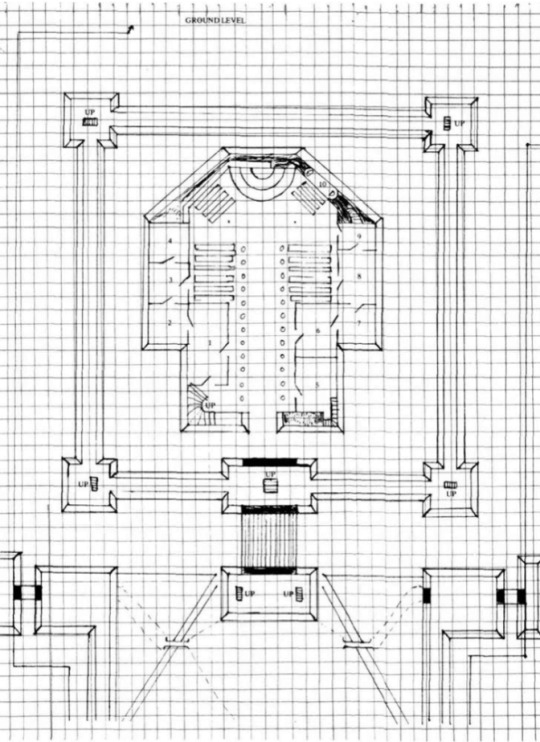
It's kinda charming though. This could be anyone's first map. My first maps looked kind of like this, in fact my first dungeon map was also a big church. A lot of early conventions are already here: a map is provided, on grid paper. Rooms are keyed, evocative descriptions are given (although this is actually pretty ho-hum, stating things as boring fact). The preamble is adequately interesting, but doesn't really establish any important context information about the actual conquering of this temple (the key system would be nice to have first, rather than buried halfway in, but be nice it's the first one). Conspicuously missing: any information about suggested starting level or party size. Now there is a old-school tendency that the levels of a dungeon should increase in difficulty about one level per….level.
In traditional Arneson form, there's some scifi bullshit going on. Here's some fast tidbits about this module:
The new head of the temple is an alien. His magic devices are all technological devices. There's spaceships. It's not my jam, but you simply have to accept that scifi/fantasy fusion was the trope of the time, it is completely ubiquitous in 70s fantasy books.
There is a weirdly complicated system of magic (technology) rings that control doors. There's a hierarchy to them that takes a whole page. It's clearly very important to Dave!
There's something about timeshifting that is, frankly incomprehensible to me. I do like hiding the big secret lair under a giant organ, though.
After you get through the first floor of so, so many people wandering around, we finally have monsters. A room of medusae (former captives), gargoyles operated with scifi bullshit, magic chains that turn off traps, giant rats and skeletons.
There's some very fun verbiage here, "each [medusa] taking 16 hit points". Like, taking 16 points worth of hits. It makes sense but there's something very fascinating of seeing this period where the metaphor of hitpoints is not just A Thing That Has Always Existed, but clearly something you have to explain to people and they are still thinking of it in less abstract ways.
Some further fun verbiage is that at this point, "Dungeons and Dragons" is a specific book that you can reference in the way you nowadays would say "Check the Dungeon Master's Guide". Check the Dungeons and Dragons! (Fun fact: the titular Dungeon with Dragons is, in fact, Blackmoor Castle's Dungeons.)

This sentence drove fear into my heart. You are bolder than me if you're gonna run an encounter that has 1,200 enemies in it. In what I can only describe as rank cruelty, cloudkill expressly doesn't work on them.
And then the adventure just kind of ends. Dave, buddy, you can't tell me that the alien-priest reports back to the mothership and give me no means to go there. That's malpractice man! It would be my literal first port of call if I was rewriting this. I NEED TO SEE THE FROG FANDOM ALIENS' SPACESHIP.
Overall, the vibes are still very wargame. The building is a castle that feels like it's meant to be sieged more than raided. But it's the first! Anyone who runs this in 2024, and in a modern game engine, deserves a kiss on the forehead for their hard work.
8 notes
·
View notes
Text
a party: *ongoing*
me, laying on the floor with my arm over my eyes and a small circle of disciples gathering: Dragonlance is a Dungeons and Dragons setting conceived in the 1980s that enjoyed a multi-pronged marketing approach, with TSR releasing both a series of novels and a series of adventure modules that were intended to let groups of players roleplay as the story’s iconic characters and experience the important plot points for themselves. (Actually putting such pre-scripted material into play had very mixed results, but a lot of people do fondly remember this.)
The foundation of the Dragonlance canon is a trio of novels referred to as the “Chronicles” which follows the adventures of a party of characters on a quest to free their world from the armies of the evil goddess Takhisis. There are dozens of other books by various authors, but the primary writers are Tracy Hickman and Margaret Weiss, who met while working for TSR.
Dragonlance is highly nostalgic for many people and has many memorable characters and enjoyable moments, but there is one small problem with it:
It’s not good.
If you will permit me to elaborate, I-
21 notes
·
View notes
Text
The Yawning Boredom Of The Word Epic
Good god this is a dull word, right?
Cancon was a fun convention, I liked it a lot. But while I was there, I saw this word being worn into a groove in my brain. It was an all-purpose descriptor, a vague and generic positivity, a detailer of scope and an encouragement for engaging, and every time I saw it I felt a bit of my brain shut down in response. I think some of this is just the normal overuse of meaningless words. If someone described a game as being ‘lit’ I would probably also just as much immediately ignore that descriptor. Packing peanut language, that kind of thing.
And I know it’s rich, coming from me to complain about overuse of cliche. I just said ‘packing peanuts’ which is something I am very selfconscious about saying a lot.
It’s not just the ungoogleable game Epic by Wise ‘Maybe We Don’t Want To Be Called White Wizards Any More’ Wizards. It’s also games like Epic Spell Wars of the Battle Wizards: Duel at Mt Skullzfyre or Epic Resort or Tiny Epic and their franchise of genuinely exciting little games, or Crafting Epic Dungeons or Epic Scenery or Epicness Incarnate or Warhammer Epic or Epic Confrontation and you might not know if I made any of these games up, or all the other things I saw on the convention floor that just kept using the term, and every single time made me realise that in so doing, I now knew less about them than I would if almost any word was in that space.
What is ‘epic’ for?
I saw it being used to describe campaign sourcebooks and TTRPG material. It’s an interesting quirk of language that back when I was playing 3rd edition D&D, epic was a specific term used to describe the game after 20th level, which is to say, the point when the game’s rules started to break down and all the power design got exceptionally dumb. Of course that’s an old term from an older time – 3rd edition hasn’t been a meaningful frame of reference since the ye olden times of 2019 when Pathfinder 2e came out. In 4e — the best edition — the term is used to describe the last 10 levels of the game, where the game stops being about the movement of heroes and monsters and starts being about the will of demigods and resolutions of kingdoms.
Still, it looks to me now like ‘Epic’ is a thing that is used to describe a campaign that is long and has a huge scope. That’s cool and all, I can imagine a reason to want that, but I think this runs into a problem I have with the landscape of TTRPGs with prebuilt content in the first place. I don’t actually have much interest in modules or campaign setting information myself because I will almost always want to make my own, to tell my own story. Buying a campaign is weird enough to me, but then buying a big campaign, especially an extremely long campaign has all the aspirational purchase energy of the kind of person who buys roof racks for their sports utility vehicle that’s never going to be used to drive anywhere but work in the city and the shops.
Epic dungeons are somewhat in the same space in that they’re very large commitments of time and energy to a large space. Spaces are interesting to me because a space has an ideology and a purpose. The nature of a dungeon is that it’s a place with a purpose and you have to work out exactly what that means for a world — if there’s a dungeon the size of the Imperial City underneath the ground somewhere with its own ecosystem, I’m left wondering why it’s there, what’s the ideology of a structure like that.
Epic Dungeons are Dungeons, but big! Dungeons where you go down into them and what, have to spend time making beachheads and establishing places you can come back to? This is an idea that always feels to me like it works better for a videogame like Diablo, where there’s a system in place that lets you ‘save’ your progress, or a game world like Dark Souls where you can operate completely at your very edge of survival, where the nature of the place you’re going gives you a chance to restock yourself, and you don’t have to leave it except to empty your pockets.
And like, those worlds make for fun videogames but that’s a videogame? There’s no sense of verisimilitude or ideology of place in a videogame, certainly not compared to the vast freedom of a TTRPG. Yes, I’m saying Dark Souls is worse at giving a sense of place and a world than graph paper. And I should, because I’m right.
So like, what use is an Epic Dungeon as a thing you buy and drop into a world? It seems like you need a world that’s made for it, a world where it made sense for there to be an epic dungeon and a playstyle that supports it.
Epic challenges also feels like a strange place to start because what about them is epic? The scope of them? I guess that can be a way to make something feel big and impressive, but when a RPG sourcebook is promising ‘epic challenges’ I have to wonder how they make that feel that way. I remember keenly Exalted with its vast scope and how little that scope felt like it existed or mattered because the world kept winding around the same four or five people and the same villain. Are these games full of really good structural design that allows you to convey a deeply complicated scale of a problem with a huge variety of variables in a meaningfully handleable way? Or are they just full of art that shows very big things? Is it a dwarf with a big axe leaping through the air? Because that just feels like heroic fantasy, and I’ve got that.
I feel that in some cases there’s also an element of low-key snobbery around some of these ‘epic’ encounters where what they mean by ‘epic’ is ‘players can fail.’ Like there’s something about ‘epic challenges’ that means I know how to represent a real challenge, you don’t, and with all this there’s the precarity of a failure state hovering over things, a failure state that, being honest, for an appropriately epic sized kind of challenge, you won’t really see, because, like…
You don’t tend to survive epic failures.
Worlds don’t tend to survive epic failures.
It isn’t that any of the time, the impulse to use the word epic is a bad thing. It’s not like any of these companies are going to hurt for using a word that I personally just happen to think exists at the same level of writing effort as a gamer webcomic about two guys on a sofa complaining about the size of an Xbox controller.
I predict if Ettin gets to read this, he’s going to, before he finishes reading the article, send me a discord message saying ‘lol, epic.’
Check it out on PRESS.exe to see it with images and links!
2 notes
·
View notes
Text
D&D Demon Lords and Warhammer Chaos Gods - Graz'zt and Slaanesh
(Warning, some mature topics are also discussed)
Slaanesh, like other Chaos Gods, takes inspiration (sometimes probably subconsciously) from multiple sources - mythological and religious figures, literary ones, but he/they seems to be among these, particularly inspired by 2 Demon Lords/Princes from Dungeons & Dragons, that predate him/them. Here we discuss one of them - Graz'zt.
Graz'zt was first introduced in 1982's module/adventure "The Lost Caverns of Tsojcanth" (and mentioned in 1976 prototype, but solely by name).

He is here already described as the "most handsome of Demon Princes", and one of the most powerful of them (rivaling the 2 top Demon Princes mentioned before in lore, Demogorgon and Orcus). Graz'zt somewhat unique beauty, is similar to Slaanesh who is described as uniquely/most beautiful out of the 4 Chaos Gods.
As seen here, he already has a connection to Succubi (as well as Lamias, but that will be important later), and the number 6 (Slaanesh' holy number), having six fingers on each hand and six toes on each foot.
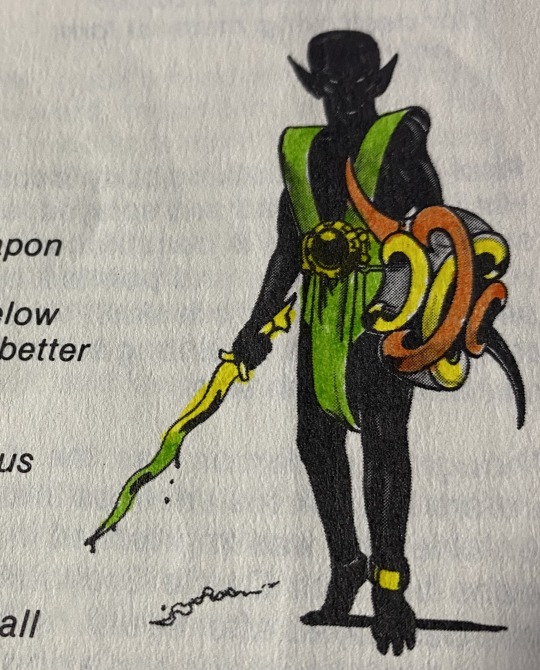
Better quality scan for Graz'zt's illustration (if colored in childhood), by Cullen Burn on Twitter
Further details about him, as shed in the 1987 Manual of Planes:
"Graz'zt makes his domain in a great palace that fills an entire layer and dominates the nearby layers of lesser demon lords. Here Graz'zt marshals his army against the forces of Orcus and Demogorgon."
And how Slaanesh's realm is described in 1988's "Realms of Chaos: Slaves to Darkness":
GENERAL: Slaanesh is the Lord of Pleasure, the Power of Chaos dedicated to the pursuit of hedonistic pleasures and the overthrow of all codes of decent behaviour. He reigns in a vast and luxuriously appointed palace in the void, where favoured followers litter the floors, indulging themselves in all forms of perverse pleasures of the flesh.
This might be a lesser similarity, but it is curious realms of both are specifically described as "palaces". And as opposed the later lore, the palaces filing the whole realm/dimension in both cases.

Slaanesh, one of his/their's only canon illustrations, exactly from "Realms of Chaos: Slaves to Darkness"
Not 100% canon, but later it's elements (partly) canonized, Graz'zt was connected to Drow in Gord the Rogue series of novels, by Gary Gygax (co-creator of D&D). Specifically, in 1986's "Artifact of Evil", the drow elf priestess Eclavdra converted to serving and worshiping Graz'zt (as did seemingly the drow of Oerth, or at least house of Eilserv, in that continuity), as well as became his lover. And in turn, he helped her to become the queen/ruler of drow. Part of this was canonized since 2nd edition, in 1993's "Iuz the Evil", with Eclavdra being described as worshiping Lolth, but serving both Lolth and Graz'zt. 2006's "Fiendish Codex: Hordes of the Abyss" indeed confirmed Eclavdra converted to worshiping Graz'zt, became his lover (and they even had a son Athux). Seemingly latter serving both Graz'zt and Lolth for a time, before returning to solely worshiping and serving Lolth. Though it makes sense, as Eclavdra was noted in the Gord novels to be certain to betray Graz'zt. This in some ways, makes her similar to the later character of Morathi from Warhammer (Fantasy and Age of Sigmar).
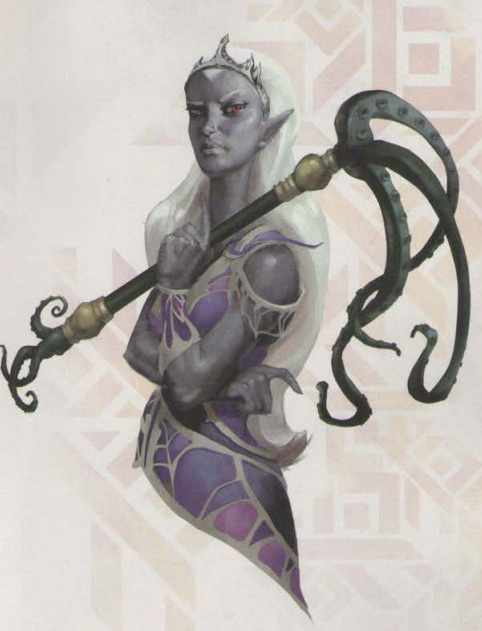
Eclavdra, 5th edition depiction

Graz'zt as presented in 1994's Planes of Chaos
"Iuz the Evil" was also the first appearance of Graz'zt in second edition of Advanced Dungeons & Dragons.
(Also, in 2E, Tanar'ri was the term used for all Demons, unlike later it being used for one, most common category)
Graz'zt and his Realm (now given a name "Azzagrat") was further developed, and changed a bit in the in 1994 "Planes of Chaos", making him , and making him in many ways more resemble Slaanesh:
"The best known of the Triple Realm's towns are actually always connected to one another and to the Plain of Infinite Portals; the connections between the three are murky to any mind less chaotic than a tanar'ri's, and sometimes makes travel here extremely frustrating. The towns themselves are often clean and even beautiful, though the streets are still mazes; the horrors of Azzagrat are hidden better than most of the terrors of the Abyss. Screams from behind closed doors are more common than blood in the streets. If a basher doesn't poke her nose in, she might not learn what she don't want to know."
"Other notorious characters include Maretta, the Lady of the Counting-House (Px/fd (succubus)/S2/CE), who watches over the revenues from Graz'zt's pacts with creatures of the Prime. Maretta rules a haven of pleasure and discipline in the underground core of Samora, a city of vice that pays huge yearly tributes to support the Blood War. Maretta occasionally sends a legion of cambion to the front, but for the most part the city is a haven for those avoiding the war. It's one of the few places in the Abyss built with an eye for excessive ornamentation; some say it's as blinding as Mount Celestia, but gaudier."
"A basher'd be smart to avoid the Argent Palace Graz'zt's abode of 66 ivory towers and a hundred cold, mirrored halls - if at all possible. The palace is a frighteningly clean, echoing place where visitors often lose their guides to the ravenous, mad bodaks and worse creatures that Graz'zt releases from his dungeons occasionally for amusement."
Here again visible the connection to the number 6.
Second edition also presented Graz'zt's very ambitious plans - of not only conquering/uniting the Abyss, but all of the Lower (Hellish) Planes, and all species of fiends, and march and defeat the Upper (Heavenly) planes (first being detailed in 1996 "Uncaged: Faces of Sigil"). If first via his servant (and possibly child), the Cambion (half-demon) the Rule-of-Three. But this was developed further in 3rd edition and later, and while it seems like an absurdly ambitious plan, it is suggested to be a real possibility.
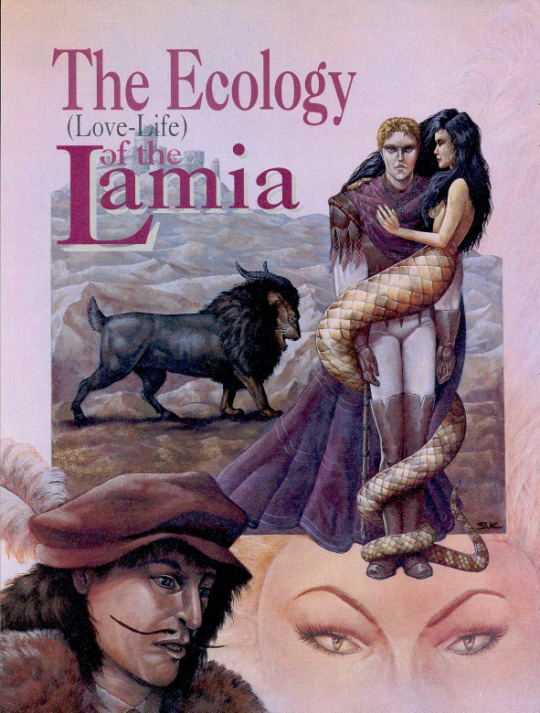
The Lamias, who often serve and worship Graz'zt, are also quite interesting, that in "The Ecology (Love Life) of the Lamia" (found in 1993's Dragon #192), it was revealed that while the Lamia Nnobles (serpentine Lamias) have two sexes, the common (leotaurian) Lamias are hermaphrodites, despite their feminine upper bodies. It's also described that only when mating with a human (and possibly demi-human), Lamias have children of their type/caste - two Lamias mating, produces Lamias of a lower caste. Common Lamias mating with humans of either sex, either being impregnated or impregnating them. Two common Lamias mating, creates a bizarre creature - S'air, the horned lion-goat on the article's cover, a being of animalistic intelligence.
S'air are named after creatures of the same name - if spelled by modern translators more often as Sayir, found in the Bible. Often translated as satyrs, goats or devils. In general, Sayir seem to be meant to be goat-like demons, possibly related to latter stories of Jinn, and the Demon/Fallen Angel Azazel. Graz'zt having some similarities to Azazel - especially seeing how the angels name is sometimes written as Azzael or Azzazel (compare to the name of Graz'zt realm Azzagrat), Azazel being father and one of the minds (and fathers) behind the conception of the Nephilim in the Book of Enoch), sometimes described as having six fingers and six toes on each hand and foot (II Samuel 21:20, 1 Chronicles 18-21).
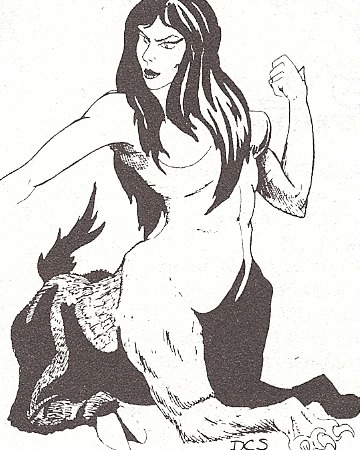
Depiction of a (common) Lamia in the original 1977 Monster Manual. Note her/their hind legs are of a goat
This makes also lamias seem a lot like the Late Medieval and Early Modern folklore about Succubi/Incubi, who were sex switching beings, that had to reproduce with humans. This was latter introduced to Succubi properly, but in 4th edition of D&D (though as will be seen bellow, implied since 2nd edition).
What is also very interesting, 3rd edition states (in 2006 "Fiendish Codex I: Hordes of the Abyss") Lamias and Graz'zt are relatives - Lamias being descendants of the Obyrith/Lovecraftian proto-Demoness Pale Night, Graz'zt's mother (as stated since 2nd edition), further showing a close connection between the two.

4E Lamia, partially in her Eladrin/Elven form, from the 2007 Monster Manual
4th Edition, for it's duration, majorly re-imagined Lamias, if still keeping their connections with and worship of Graz'zt. Here they are re-imagined as belonging to the Fey (Fairy) group (along with elves and other faerie creatures). But a truly bizarre example of fairies. Their true form being that of a hive of scarabs, around a Fey (usually elf or eladrin) skeleton, taking the form of an attractive humanoid (most commonly eladrin, elf, drow or human). They devour their victims by first seducing them, by shapeshifting to a look and gender of the target's preference. They also reproduce in a horrific, corruptive, John Carpenter Thing-like fashion, by splitting their scarab mass, devouring a (often first seduced) fey (usually eladrin, elf or drow), aside from their skeleton, and taking their form, along with their memories. Though here being further similar in man ways to Daemons of Slaanesh, and their "relation" to elves and Eldar/Aeldari.

Graz'zt, as depicted in "The Book of Vile Darkness"
3rd edition, starting with 2001's "The Book of Vile Darkness", further emphasized Graz'zt connection to pleasure and desires, as well as started using the using the title "Dark Prince" for him, like Warhammer did for a long time for Slaanesh:
"Tales are told among common folk that a dark-skinned
fiend sometimes visits witches and sorcerers, granting
them both sexual favors and magical powers. Graz’zt is the
truth of that legend. A deeply sexual, erotic being, the Dark
Prince never goes anywhere without a retinue of female
monsters—usually lamias, succubi, or mariliths. He is dangerously
charming and seductive, and he speaks with such
eloquence and grandeur that one might think him a devil,
not a demon."
"Graz’zt loves seduction and guile. Although he is not
afraid of war, he would rather trick and charm his opponents
than beat them in battle."
"Graz’zt enjoys blood sacrifices made in his name, and
sexual rites are important in services dedicated to him as
well. His temples are dark, secluded places
where orgies are common."
This edition also added to Graz'zt design the fact he has 6 small horns.

Graz'zt as depicted in Dragon Magazine #360, "Demonomicon of Iggwilv: Graz'zt"
5th edition, further developed Graz'zt in Out of Abyss making him again even more similar to Slaanesh:

Graz'zt in Out of Abyss' promotional materials
It's also worth to note that Graz'zt, while primarily male, his gender and sex were started to be presented as somewhat fluid (similar to Slaanesh since his debut), starting in Second Edition.
In his debut in this edition, in 1993's "Iuz the Evil", he is described:
"Graz'zt rules three Abyssal planes and is a powerful tanar'ri Lord. He is proud, and unusually self-controlled and cool for a tanar'ri. His favored form is that of a very tall and heavily-muscled, ebony-skinned man, with glowing green eyes, pointed ears and small fangs. He also has the peculiarity of being six-fingered and six-toed in whatever form he appears in."
This is basically repeated in the above mentioned "Planes of Chaos":
"Graz'zt, a powerful tanar'ri lord, rules three Abyssal layers. Also called the Lord of Shadows or the Lord of the Triple Realm, Graz'zt is known for his pride, unusual self-control, and coolness (uncommon for a tanar'ri). He favors the form of a very tall and heavily muscled ebony-skinned man with glowing green eyes, pointed ears, and small fangs. He also has the peculiarity of being six-fingered and six-toed in whatever form he appears in."
These just state he has a propensity to change form...but 3 years latter, in 1997's "Faces of Evil: The Fiends":
"GENDER
It's not uncommon for the tanar'ri to take genders as they will. Some days they're male, some days female; some days they're neither, and some days they're both. They tend to stick with one or the other as they grow older, and to all those who think this implies order or stability, why, I argue that it's simply another example of the fiends letting the strongest urge dominate (as they do in all other aspects of their lives)."
Suggesting together Graz'zt probably also assumes female and nonbinary forms, aside from his main form.
This was further suggested in 3rd edition (specifically 3.5E), were Graz'zt was shown, as part of his feud with the Queen of Succubi Malcanthet, transform into/impersonate her, as seen first in lore of the Demon Lord Kostchtchie, in the 2006 article "The Demonomicon of Iggwilv: Kostchtchie: Prince of Wrath" in Dragon #345:
"The conflict between the Dark Prince Graz'zt and the Queen of Succubi Malcanthet is one of the most notorious in the Abyss. When Graz’zt hit upon an idea that would not only humiliate Malcanthet but might provide him access to the Stoldottir Gate, he put a dangerous plan into motion. Disguised as the Queen of Succubi, Graz'zt managed over the course of hundreds of clandestine meetings to seduce Kostchtchie and gain his trust, convincing him that, as Malcanthet, he wanted to be Kostchtchie’s bride and merge their resources to destroy several other demon lords."
Kostchtchie, thanks to the real Malcanthet's manipulation on her own, discovered the truth, and went into a complete rage. But what is interesting, it's also described as such:
"Yet to Kostchtchie, nothing could have been more humiliating. His realization that he had been manipulated by a woman (even if that woman was actually Graz'zt in disguise) fueled his misogyny like never before, and the fact that the other tanar'ri lords (Graz’zt in particular) now viewed Kostchtchie as a besotted fool triggered one of his greatest rages ever."
Stating Kostchtchie considers Graz'zt at least partly a woman, and even the text seems to partly agree. And this even fueled Kostchtchie's misogyny, not homophobia, or any form of queerphobia.
Graz'zt again impersonated/transformed into Malcanthet in 2007's "Expedition into the Demonweb Pit", as part of his plans:
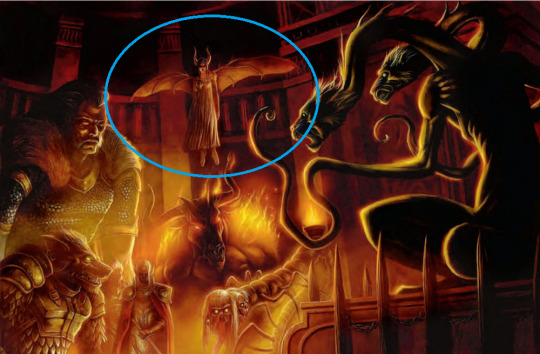
Graz'zt impersonating Malcanthet, circled
And in 5th edition, in "Out of Abyss":
"The appearance of the Dark Prince is a warning that not all beautiful things are good. Standing nearly nine feet tall, Graz'zt strikes the perfect figure of untamed desire, every plane and curve of his body, every glance of his burning eyes, promising a mixture of pleasure and pain. A subtle wrongness pervades his beauty, from the cruel cast of his features to the six fingers on each hand and six toes on each foot. Graz'zt can also transform himself at will, appearing in any humanoid form that pleases him, or his onlookers, all equally tempting in their own ways."
In general, these similarities, and possible inspirations are very interesting, especially how it seems Graz'zt and Slaanesh started to mutually influence each other.
#slaanesh#graz'zt#dungeons & dragons#advanced dungeons & dragons#dnd#inspiration#mutual influence#warhammer#40k
24 notes
·
View notes
Text
Dungeon23/12/01: the Harbinger
The entry door to this small, simple antechamber can be readily barred from the inside, but it is unlocked when the players come across it. A single gnome-like creature stands vigil inside, prepared to recite the words that are displayed on a brass plaque behind them, which explain:
This Is Not A Place of Honour.
The guard will not prevent the players from passing through, but insists only on warning them that the space beyond is different from the dungeon they have been exploring up to this point. What lies beyond is not meant for the amusement of the players; it is a place of suffering, meant only to kill them – efficiently and cruelly.
Welcome to December, folks.
I have 31 more rooms to design (well, maybe more like 40, but we’ll see), but the strange situation in which I find myself is that December is not going to be a proper “floor” unto itself. If you’ve been with me through the whole year, you might recall moments where I indicated that I was replacing or swapping some rooms. You might also recall how I said I was chopping up the rooms from March to fill slots in other parts of the dungeon, and I’d have to backfill the remaining stuff. Well, here’s the deal: December is the month where I go back over all of these gaps that I created over the course of the year and fill them in. It’s also the month where I do a little “editing”, reviewing the room list as it exists right now and deciding whether any more rooms need to be made, replaced, or relocated.
As a result, I honestly don’t have all that much to post – this month is going to look a lot like October did. I might drop something in a week or so just to report on my progress and whether or not it looks like I’m going to succeed with the challenge, but otherwise don’t expect too many more room breakdowns until the 31st (when I’ll post my last room and declare either victory or defeat).
You might be wondering, however: if December doesn’t have a floor unto itself, then what exactly will be the 12th “theme”? Well, the full explanation has to do with the way that March got “chopped up”, plus the fact that I’ve actually decided to swap around a few of the different months in order to expand/shrink floors that had more/fewer good room ideas. The current iteration of the monthly schematic looks like this (barring any further changes I may make here in December):
Tutorial
Labyrinth*
Founder Ruins**
Desert
Fey Forest
Volcanic Cave
Embattled Keep
Water*
Clockwork
Vampire’s Estate
Extraplanar
Death Trap***
*Making mazes was like pulling teeth by the end of the month, whereas I have bizarrely found that I keep coming up with new water-themed room concepts here and there. So I’m going to axe three of the weakest mazes and replace them with three new rooms for the water dungeon.
**By the end of the Desert floor I was actually struggling to find room for all of the fun, Indiana-Jones-inspired ideas that I made for the inside of the “pyramid”. So now I’m treating the pyramid as a transition between the desert and founder ruins within (and the ruins will get some additional connections to other floors). The Desert floor, meanwhile, will be backfilled with even more “mirage” inspired encounters. These two backfills will make up most of the rooms generated this month.
***The last of the former March rooms are coming here, to the death trap, which is also what today’s room is all about. It’s the full circle from January’s “tutorial” floor: a dungeon level where the rules have changed, and I’m just gonna try to murder you, Tomb of Horrors style. I’ll be pulling forward the weirdest and deadliest rooms that I created during the year as “homages” to classic D&D modules, plus adding a few more this month to round myself out to the full 365.
3 notes
·
View notes
Text
306. Garry Spiegle - AC3: The Kidnapping of Princess Arelina (1984)
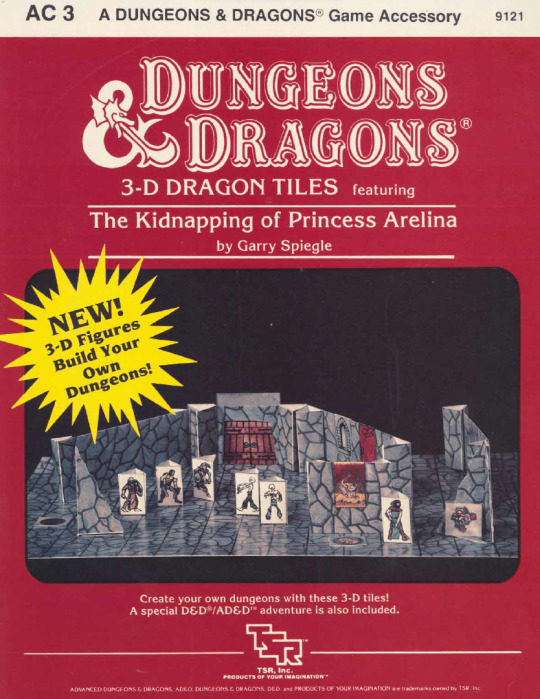
A module that is both adventure and DM accessory, this is particularly notable for the cardboard pieces that can be used in this or other adventures, these include 3D character models and floor tiles that you can use to build your dungeon.

Together with the cardboard accessories you get a small and straight forward adventure of the "rescue the princess" style. Not much to say about that, except that it does have the interesting distinction of containing, in each room, details on how to set it up using the pieces provided.

So, more of an accessory than a module, really, as the adventure is a bit ho-hum, it's still a pretty interesting D&D product, which was also compatible with AD&D (obviously) and started the Dragon Tiles series, which would have plenty more entries through the years.

2 notes
·
View notes
Text
NOTES ON LEA’S SHOP / EDDA GAMING.
A two-story + basement structure that is a holdover from an older time in Hawkins. The main floor comprises of the shop proper, with a small step-down on the left whose purpose has shifted over the years. There is also a stairwell up to the top floor, which makes up Leah’s living space. The basement is set up with tables, chairs, and lighting for campaigns. Overall, the building is cozy without feeling cramped, and Lea has clearly put thought into the setup of both product and displays to keep things looking good for customers.
Lea mainly deals in tabletop games and their supplies, with a focus on Dungeons and Dragons given the region. That said, she also sells a number of war games and associated interests of the era. She dabbles in counterculture clothing and accessories, as well as comics catering to a nerdier crowd than most. She sells Elfquest and Sandman, for God’s sake. At some point upon returning to the brick and mortar location, Lea shells out for a Commodore and various fantasy games in a bid to drum up additional customers.
Has had to ask Dustin to please save his Temple of Apshai game and let Erica play Labyrinth, only to realize Dustin is no longer using the Commodore to play a game. Dustin, what the fuck my good dude--
She tried to dabble in stocking fantasy/scifi literature, but it wasn’t profitable enough to maintain. The only novels that pass through now is what customers bring in their bags or whatever she’s reading herself.
She briefly had a mall location in the Starcourt, but it was taken the absolute fuck out by Upside Down forces during the big climactic battle even before the mall collapsed. Woman cannot win for losing.
She absolutely does not mind kids and teens loitering. She remembers being an awkward outcast in her own teens, and wishing she had somewhere to escape to. Catch her chatting with kids that park it for hours without buying a single thing.
Runs a yearly Ravenloft campaign to keep kids that might otherwise have targets on their back off the streets on Halloween. She gets a ton of candy, orders pizza, and then argues with Eddie an hour prior to the session because no, he is not forever DM in her shop, Eddie. Her game, her shop, siddown.
Known to cut deals with regulars, especially if they’re willing to give her feedback on a new module or let her know what’s currently popular.
Has absolutely flirted with Karen and Joyce in the past, when they used to come in with their little nerds. She does i just subtly enough that she doesn’t get ran out of town, but she hopes if either of them are amicable to the idea, that they pick up what she is putting down.
Season Four’s shop arc is called ‘If That Stupid Cult Kid Comes Near My Shop I’m Breaking Out The Weapon I Started Keeping Behind the Counter After All Those People Went Missing.’
I have the image of pre-season one core four carrying their entire campaign, game map and all, down to her shop so Lea could settle a disagreement about rules. Lea didn’t have it in her heart to tell Will that her own campaigns run on ‘rules are secondary to a good time/good story.’ Either way, she’s considered the Rules God among local players.
5 notes
·
View notes
Text
youtube
Module: Programming for 3D : G6080
Task: Demonstrate your profiency in basic unity fundamentals in game design.
Skills Acquired: Unity (Particle systems, Game Mechanics,Texture, Spatial Sound) , C++ Scripting
Game Controls:
E: Pick Up Object
Right-Mouse Button: Throw Object
Game Objective Summary
Characters: Main player.
Action: Player must initiate the spawn system and pick up spawned object.
Action: Player must also step on tile in front of the main door to open it and step on the tile behind door to close.
Action: Player must throw spawned object downstairs.
Action: Player must collect items, survive and avoid traps.
Player Goal: Collect 10 crystals orbs to escape the dungeon.
Flowchart: No decisions made at this point: If level is completed, player wins the game. If player takes full damage during gameplay revert to game over overlay and prompt to try again.
Scene 1:
Location: A narrow hallway dimly lit by torches, with elevated tiles on ground and door at the end.
Scene 1.5:
Location: Stairway to the second floor.
Scene 2:
Location: Room filled with traps, crystals, and other assets.
Scene 2.5:
Location: Trap-infested hallway, stairway to third floor.
Scene 3:
Location: Dimly lit room with an ancient platform.
Music: Mysterious background music surrounds the environment as the game goes on.
Notes: Player is trapped in the dungeon, The only viable way out is to collect crystals, avoid traps, and activate the platform.
0 notes
Text
#1 Game Goal, Assets, How to Play
Here I go over how my thoughts on how the game should go. Similar as possible to Decked Out, but modified to be more like a boardgame so there's no real-time events. There will probably be some overlapping explanations as I go into more detail on the assets themselves in later posts, but I'd rather overlap than omit something important.
So this is more of a tool to go alongside dnd rather than being a written module campaign like curse of strahd. More like inserting dnd into a board game. It might work, it might not. Will have to test. After the cut I go right in with how I think the game will work.
Aim of the Game:
Run the dungeon, collect artifacts, survive, upgrade your deck, do higher difficulties until you can escape.
Assets:
Boards
Dungeon Board: Where the Room Cards are placed. There are twenty spaces on the board. These are labelled from A1 to E4. Level 1 connects the Hub area in the corner to the Dungeon area.
Room Board: When players are in a room, they are placed on the Room Board, which acts as a map and allows them to move on a grid and see their surroundings such as the environment or enemies.
Cards
Room Cards: x20 Lvl 1, x20 Lvl 2, x10 Lvl 3 cards. Room cards contain a preview of a room that the players will explore. Each card is placed face down on the appropriate difficulty board, and the closest one to the waiting room is flipped up when the players enter the dungeon.
Each card also shows four pathways, one on each edge of the card, and the players decide which pathway to take and flip over the card in the chosen direction, then flipping the room card they were just in face down again. Room cards will have 1-4 pathways that are red. These can close off when Hazard is played.
Clank Cards: A deck full of Clank cards. 20 Clank cards are shuffled into the players’ deck at the start of a run.
Player Cards: These cards are for players to purchase and use. There are three main types:
Normal: These cards are played when drawn during the dungeon.
Ethereal: These cards are removed from the deck after being used and can only be used again if purchased again.
Permanent: These cards activate automatically at the start of a run.
In addition, there are tiers of cards going from Crown, Common, Uncommon, Rare and Legendary.
Artifact Cards: These are drawn by the Dungeon Master at the start of a Run. They are separated into lvls 1, 2 and 3. The number of Frost Embers awarded for retrieving the artifact is written on the card. The location of the card is written as A3, C4, etc. and relates to the notation on the board. They also show locations where Ravagers spawn.
Treasure
Crowns and Fragments: These drop throughout the dungeon during a run. Four Fragments can be converted into a Crown, which can be converted into Gold. Gold can be used to purchase items and Crown Cards.
Keys: These sometimes drop with other Treasure drops. A key is required to access the next floor when doing higher level runs.
Frost Embers: These also drop throughout the dungeon but are separate from Treasure. The main way to acquire these is to retrieve an Artifact and return to the Hub alive. These can be spent to buy more powerful cards.
Monsters
Cruel Monsters: Spawn when sufficient Clank is generated. These are forces of nature that deal a lot of damage, cannot be killed.
Ravagers: Large, hog-like monsters that charge at you when they see you. There are a certain number on each floor and spawn in locations depending on the Artifact. These will follow players to new rooms unless they lose sight of them.
Vex: Only spawns at Max Clank. Hostile ghosts that fly at players relentlessly.
Wardens: Only spawn on level 3. Blind, but can hear very well and shoot sonically charged shriek projectiles.
Room Monsters: These can appear in certain rooms when the players enter. These will not leave the Rooms they were found in. In general, they are significantly weaker than Cruel Monsters.
___________________
My main concern right now is I might potentially have too many card types. I plan to make some visuals as far as the board and cards go so that it makes more sense. When I do that I might make this post again but with pictures to make things clearer.
___________________
Setting up the game.
Shuffle the Room Cards and lay them out on the Dungeon Board face down in the appropriate levels.
The players are given a deck with three cards in it: Treasure Hunter, Ember Seeker and Moment of Clarity.
This deck is what they will build throughout the game by buying cards with Frost Embers.
The players start the game inside a Hub area that has NPCs which can sell every dnd item at the normal price. They also have their starting equipment.
Before running the dungeon, the players should prepare their items and deck.
The players are given a deck with three cards in it: Treasure Hunter, Ember Seeker and Moment of Clarity.
This deck is what they will build throughout the game by buying cards with Frost Embers. When the players finish preparations, they can run the dungeon. First, select difficulty level: 1, 2 or 3. This determines what level of the dungeon the players must reach. Second, the Dungeon Master draws a card from the Artifact Deck of appropriate level, which tells the coordinates and Frost Ember reward.
__________________
Running the Dungeon.
Players shuffle 20 Clank Cards into their deck. The players are not allowed to see the deck during a run (as Clank Cards have a different coloured back).
When the players enter the dungeon, the DM only tells the players if the Artifact is North, South, East, West or in between two. Each time the players enter a new room, the DM again tells them.
When entering the dungeon, players begin in the bottom-left space of the board and flip the card over. Each Room Card represents either a social, combat or environmental scenario that the party must resolve. After doing so, they can choose which direction to go. After deciding, they flip over the next Room Card and flip the previous one face down. When players acquire the artifact, they must return to the Hub with it. Players can return to the Hub without an Artifact, but any other items acquired such as Treasures or Frost Embers will vanish. During a run, players must be wary of Clank and Hazard.
Depending on what Artifact was drawn, Ravagers will spawn in certain rooms. If a Ravager sees a player, it will pursue them until it either kills them or loses sight of them, even chasing across rooms.
____________________
Clank
Clank is an effect that builds up over time. It has no effect until it is maximised.
Some ways Clank can be generated include (but are not limited to):
Drawing a Clank card from your deck.
Each time a new room is entered, 1 Clank Card is drawn from the Clank Deck.
After finding the Artifact, 3 Clank cards are drawn.
Certain cards will cause Clank cards to be drawn when played.
When an hour passes in-game, 2 Clank cards are drawn.
Clank cards are placed on the side of the board. When w0 Clank cards are in play, it is Max Clank, and no more cards are drawn any deck until the run is over. When Max Clank is reached, one Vex spawns for each player, and they will pursue and attack the players through the dungeon.
Clank can be prevented with Clank-block cards. A card with Clank-block displays a number of how many Clank cards it can block. The next Clank cards drawn (up to the number of Clank-block shown) are placed on top of the Clank-block card and do not count towards Max Clank.
Clank resets at the end of a run.
Hazard
Every time a room is entered, or an hour passes in-game, the players gain 1 Hazard point. When a Hazard point is gained, the DM flips a coin for each Hazard point. If the coin is Heads, nothing happens. If it is Tails, the red Hazard door(s) marked on the Room Board closes off and can no longer be traversed through. Hazard Points reset at the end of a run.
Artifacts
Artifacts are obtained in the room that they are designated to. The room will have either a social encounter, combat or environmental puzzle to solve. When solved, the usual reward is replaced with the Artifact. Players must return to the Hub with the Artifact to get any reward.
Treasure Drops
Each time the players enter a new room, a coin is flipped number of times depending on the dungeon level. If it is heads, the room contains Treasure. The DM rolls a d6. On a 1-5, they find that many Crown Fragments. On a 6, they find a key. Cards can increase the amount of Treasure found as well as how many coins are flipped.
Crown Fragments have no value on their own and vanish upon returning to the Hub. However, four Crown Fragments can be combined into one Crown, which can be taken out of the dungeon. Crowns can be spent at the Crown shop or converted into Gold Pieces (GP). 1 Crown is equivalent to 100 GP.
Keys cannot be used at shops but are required to access higher level floors. Keys must be brought to the correct Room Card that contains a Staircase.
Frost Embers
These can only be acquired by retrieving Artifacts or with cards that generate them. When the players return to the Hub, they can spend them on cards or other exclusive items. They cannot, however, be stored. When a new run is started, any unspent Frost Embers vanish.
Cards
These can be purchased from the Frost Ember shop in the hub. The more cards added to the deck, the less likely you will draw a Clank Card and the more likely you are to draw a beneficial effect instead. Decks can hold a maximum of 40 cards and a maximum of 5 of the same card. Should the players acquire more than 40 cards, they must select which cards to leave out when they enter the dungeon.
___________________
This is where I start mixing it in a little bit with DnD. In a typical campaign setting, you get gold from doing quests and stuff. In this one, you get it from running the dungeon and returning with the Artifact. I wanted it to still feel like DnD and so not be as defenceless as actual Decked Out. Important to note, Ravagers and Vexes can't be defeated, so their weapons and stuff will be mainly for Encounters in the Room Cards.
_______________________
Finishing a Run.
After the players successfully return to the Hub with their Artifact, Frost Embers and Crowns, they convert the Artifact into Frost Embers and can spend them to buy cards and other exclusive items at the Ember Shop. Crowns can be spent at the Crown shop or converted to GP to be spent on dnd items.
Frost Embers cannot be stored and vanish when starting a new run. GP and Crowns can be stored and saved up.
How to Win
Successfully returning from a run is all well and good, but it’s not quite enough to win the whole game. For that, the players must save enough Frost Embers to purchase a Black Key. The Black Key must be taken into the dungeon on the highest difficulty level and brought to the correct Room Card containing the Door of Victory. Entering the Door of Victory brings you to the final level, and only by completing the final level can you truly escape Decked Out…
_______________________
Again the part about GP is for the dnd part. If I make a standalone version of this I may remove it entirely.
I'm not really sure how to order these segments. I think I need to actually talk and explain to someone out loud like I'm trying to teach them how to play so that I can work out what order to do it in. Again, I think visuals will help so I'll work on those soon.
That's all for now, next post I'll try to do this one again but with pictures accompanying it.
1 note
·
View note
Photo
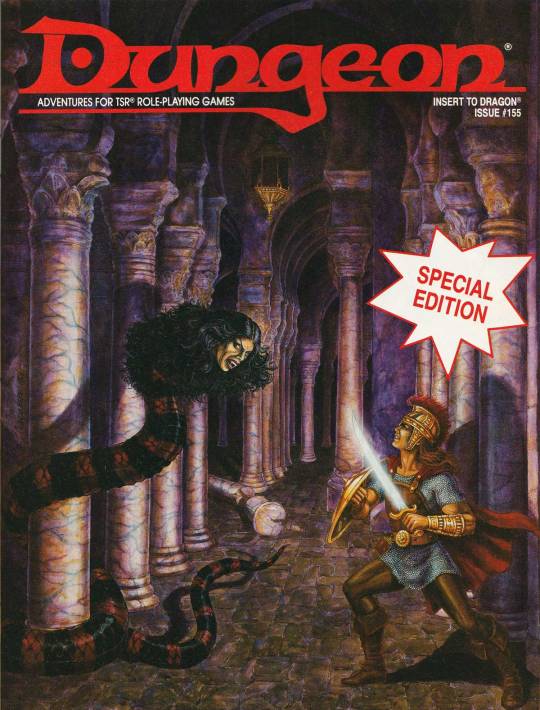
Confronting the spirit naga in “The Crypt of Istaris,” Richard Fichera’s AD&D tournament module from the Gateway ‘85 convention, printed in Dragon magazine 155, March 1990, as a special Dungeon magazine insert (edit: art by James Faulkenberg -- thanks, @mrdestructicity, for pointing out the signature along the left edge -- I zoomed in on every line in the floor tiles and every vein in the marble columns before giving up on finding one)
#D&D#Dungeons & Dragons#spirit naga#dungeon#Dragon magazine#Dungeon magazine#fighter#magic sword#The Crypt of Istaris#crypt#columns#naga#dnd#Richard Fichera#Gateway convention#Gateway '85#1980s#TSR#Dungeons and Dragons
220 notes
·
View notes
Text
And so it begins
I pasted this post from my Substack for convenience and will probably do so for the subsequent entries. Feel free to subscribe to the newsletter to get them as they release.
INTRO
First entry with reading notes about a "first adventure" module (we are getting meta already). I'm also getting into the dungeon23 challenge with my own twist on the formula.
I’m still forming the newsletter concept as I’m writing this entry (isn’t that the beauty of language? Barely knowing what you’re going to say before actually doing so). I would like to use this part to talk about what I’m working on and extract some of my thought process. My guess is that I’ll keep updating it endlessly because the reflection on a feature sparkle new ways to improve it again and again…
… Interestingly enough, that’s not what happened. Instead, I expanded this intro into another full-fledged article about “Skills” that I decided to separate from this entry. Maybe I’m digging writing even more than I thought. As for this part, I start to wonder if I need it at all, I’ll leave this one for posterity.
READING NOTES
In that part I’m using one RPG, Module, bunch of Articles or even Podcasts as support to raise design questions and start answering them. What catches my interest will most likely be very subjective, so don’t take that as a review (Although, it will give insights on what it’s about, so it can help you form a decision I imagine)
And for the first entry we dive into…
A Most Potent Brew - A Basic Rules Adventure
Free to grab over here
A classic I heard, and indeed, this module has a lot of good traps that … how can I say … “caught” my attention.
The first one is about finding clues in a poetry and using them to move on a specific part of a mosaic floor to avoid being cut in halves. I'm not keen on enigma, so I overlooked it. What got me thinking instead are the following two encounters that "felt" like traps:
The slowly approaching fire spider makes for a great cinematic moment (triggered memories of Queen Gohma for the connoisseur) when you finally notice the glowing silhouette that has been lurking over you from the dark.
The rat, drinking the "enlargement" potion, becoming a (larger) threat after one minute if not taken care of.
The characteristics that separate traps and encounters can easily shift, making their definition look similar. The former could be in motion and even have a state bloc if you want to leverage the combat system or opposite checks. Likewise, the latter can feel like a static puzzle with a clear way to "disable" it and avoid the bad outcome.
Now, more than lexical consideration, those two encounters share a common flow:
You enter a space with several intriguing things and clues about a threat.
A timer starts without players knowing about it.
Depending on their actions, they'll have a more or less challenging outcome.
That sounds exactly what a trap design should be. You have several options, and you need to make the right one to avoid something undesirable. The first example was a static choice clearly telegraphed as an enigma; players don’t have any time constraint to process and think it through. Contrariwise, the other two are only hinted, and the puzzle becomes to figure out what's up before it's too late.
Last note on a different aspect, I also liked the simple tension arc of the module: From a friendly pub to a mysterious old space, to a dangerous dungeon, back to the safety of the starting point for a casual debrief. I had the same vibe reading through the Hobbit when, after all their adventure, Bilbo and Gandalf walk the way back home. We could call that a “diegetic closure”, and it may have a special place in TTRPG.
BIT SIZE REVIEWS
In this section I put 3 links with just enough context so you can get if it’s worth your time. Expect to find reviews, design breakdown or even content on adjacent topics for inspiration purposes.
Art Book Excerpt (≃2 minutes) → Retro computer graphic dark fantasy by Plastiboo
It seems to be out of stock at the moment, but the picture still makes for great inspiration on a niche genre. You can follow the artist here or on Twitter.
Podcast (≃1 hour) → Designing Monsters for RPGs with Greg Stolze and Caleb Stokes by RPPR
The whole conversation feels a bit disconnected (with good vibe nonetheless).
Provides insights on horror game design with some great pitches like: A (truly) giant beast that may smash you while wandering. Players may want to "get inside" it because it doesn't digest precious metal. You’re effectively taking the position of bacteria, competing with others at a completely different scale.
Not exactly mentioned like that, but there is an interesting correlation to be made between HP and “time on screen.” If a monster as a low amount of HP, it may not live long enough to develop complex skills over an encounter. On the contrary, you don't want a large pool of HP remaining if there is nothing fresh to showcase on the next round.
Video (≃7 minutes) → Dungeon design tips by Baron de Ropp
Great collection of topics that could each become the starting point for a full design conversation.
A ROOM
This section is dedicated to actually making something. We can talk and reflect and talk again about that reflection, sparking a new one that… Gathering knowledge; accumulating ideas; you also need to just DO. That being said, I still wanted a framework, a big picture in which all my small expressions would take a deeper meaning. Sean McCoy (main designer of Mothership) happens to give me a starting point … while, in the meantime, arguing that it isn't the way to go… Thanks anyway
In this post on Substack he began a trend that you can follow with the hashtag #dungeon23 on Twitter. The goal is to make a room per day during 2023 with the hope that it might make a full-fledged mega-dungeon down the line. The idea is appealing, but I still needed to:
Connect it fictionally to my RPG Bonaventure (not at all a dungeon crawler).
Get a basic understanding of the game flow I want…
… So I can define the key points that need to be described for each space.
I didn't fully answer those points, and I shouldn’t try to, because the goal is to make something first and foremost. Here’s my initial take anyway:
I’m playing with the idea of a spiritual world living side by side with the grounded, near future backdrop of Bonaventure.
This structure struck me as a perfect opportunity to make a Roguelike: small encapsulated bits of content arranged by a system to produce an interesting level in real time (Which I would translate with “at the table” in this instance).
In addition to environment and inhabitant description (namely rooms and monsters), I want to focus on its “connectivity” (dead end, fork, pathway, loop, going deeper) and potential “foreshadowing/after effect” (how does it affect other space when it comes online)
OK ... see how quickly this section gets filled with thoughts, “DO” we said; here it comes:
Room
Two golems in a room (6 m tall) both extremely strong, but equally built. They’re similar except one as a red glyph and looks one side while the other as a different mark painted in blue and faces the opposite direction. They’re chained together with narrow yet indestructible links. The chain is just folded two times around the central pole of a giant crank. It would be easy for them to coordinate and free themselves from it, but the titans are constructing their own self by opposition with the other. If one wants or say something, its counterpart readjust to focus on the contrary.
The room is high but narrow, making movement around in golems‘ reach. Each one will seek validation of the players as they pass by. If one is confronted, it will build anger and finally attack (grabbing and tearing apart). The other will try to defend the victim, although, in a limited capacity because it keeps facing the opposite direction.
Side Content
A massive door with engraved representation of an army of golems marching in unison against a “dark figure” (this figure could be replaced with any important character already defined). This door is open if you find a way to turn the crank in the room.
Deep voice arguing over a topic; tinkling of a chain.
1 note
·
View note
Text
Pre-G1 Modules, part 4...A - The Judge's Guild Roundup
Part 4a? This is one of those projects that keeps ballooning in scope forever.
Again, keeping with the theme of "trying to not get too historical", Judge's Guild was a group formed by Bob Bledsaw and Bill Owen to release DM aids, in part because then-TSR didn't think it was a viable market. Note that this is Bob Bledsaw Sr., the guy responsible for the nazi incident at Judge's Guild a few years ago was Bob Bledsaw Jr. Anyway, JG was responsible for a lot of materials ranging from setting materials, adventure modules. A lot of luminaries ultimately come from JG, including recently passed legend Jennell Jacquays, so they're a very worthwhile topic to review. I will not talk everything they put out between 1976 and G1 because I'm already planning on touching on (edit: 3 of 6) items today, so we will focus only on their for-sale, non-serial modules.
City-State of the Invincible Overlord (1977)

This is stretching the definition of module -- it's more of a setting book. CSIO is a setting supplement for, yeah, a city state of an invincible overlord. I hope you like maaaaaaaaaaaaaps! Essentially, an overlord stays above and aloof to the factional struggles of the people beneath him, roman emperor-style, and details out a bunch of characters and places within a city. It's, actually pretty good, I think a modern revision of CSIO would probably be pretty fun to play in, especially if you omitted a lot of 1970s gunk (like the frequency of slavery). It has this nice quality where it's much more brief per-location than modern city sourcebooks, but has many many varieties of the same concept. You might want a tavern, and there are so many to choose from. Here's a random assortment of buildings you can find in this book:
A park of sexy statues with a pleasure cult hiding in the rush
A 'fear shop' where the owner will go to ridiculous lengths to scare you
A GILF brothel
The tavern that Fafhrd and the Grey Mouser always go to
A siege engineer you can bribe for promotions
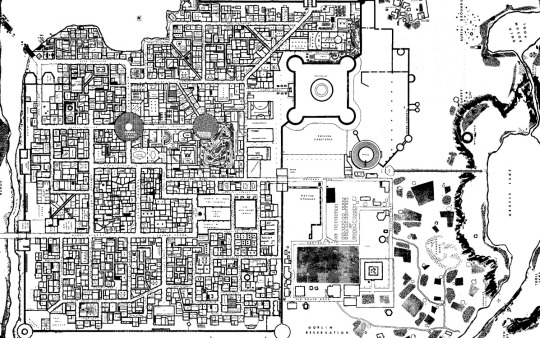
The map is almost, too comprehensive. I'm not sure what % of buildings are described but it's gotta be close to 20%, which is REALLY HIGH by ttrpg city standards. I'd guess that Green Ronin's Freeport is maybe 1% described. The book also has the traditional regulars of a city book (laws, sewer maps, factions) as well as the admittedly novel idea of a full advertising system to acquire hirelings. It, probably didn't merit a full page, but the idea of caring this much about where precisely those hirelings is coming from is kinda novel.
Regardless, this is an adventure module review blog, not a city review blog, so we have done our due diligence and may now proceed.
Tegel Manor (1977)
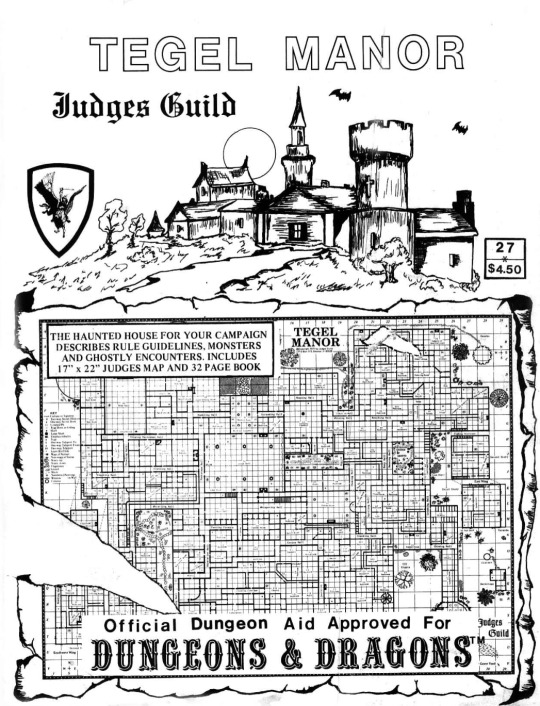
Oh boy, it's a megadungeon. Here we go. So despite that ominous cover, it's only 30 pages, so it could be worse. The essential schtick of the adventure is that there's a destitute (by noble standards) paladin who owns the deed to an extremely haunted mansion and is desperately trying to pawn the problem off on someone else. You can bully him into helping, but he's a complete coward.

The house is magically fireproofed because adventurers are just like that. A good sign, I think? Surely this won't be a tedious monster closet festival? We have a pretty standard rundown of a town and,

That's one of the most unfortunate names I've ever seen. If I was a dwarf named Cretin Nodcock, I feel like I would also not give a damn about my appearance. Or maybe work on a name change. This adventure really lavishes in its old timey words, we have a paladin described as "poltroonerous" (cowardly), a passing mention of "white wassail" (a mulled white wine), et c. Relatively little is given about the surrounding town and countryside, just enough to get us into the manor asap.
The first floor is a greatest hits of a haunted house. Animated knives, disappearing ghosts, screaming, the walls ooze GREEN SLIME, et c. Here's the stuff (across this entire dungeon) that isn't rote:
A creaky floor that gets so loud that it stuns elves' sensitive hearing while a wall crusher goes off
An animated yellow mold that looks like a sleeping woman
An animated painting of a battle that shoots arrows outward randomly
An animated painting that paints the party, and if it succeeds the party is petrified
Rust monster on flying bed action
A room of opaque gas-filled tubes that contain a variety of people, monsters, objects in animation. I bet the elf lord would have some nice things for their rescuer.
The level of haunting really goes down and it just becomes an assemblage of roughly halloween monsters in increasingly ridiculous patterns. If I was running this, I'd probably shrink the manor down into a greatest hits version of these rooms, because this is a SPRAWLING manor and it's room after room of "there is a wolf, there is a wight, there is a moldering desk". When you think of Gygax going "why would anyone want to buy a module?", this is sticking in my mind. It's not "Dwarven Glory" bland but it IS a never-ending gauntlet of monsters punctuated by silly rooms.

A rare luxury after all the room-by-room shit. Just some good ol' fashioned silliness.
Inexplicably under the house is a further dungeon-dungeon, which is mostly rat tunnels. Happily some of these maps feature little blank lines to mark your revisions from the official map, which is a nice little conceit.

I am always, always, always happy to have a new riddle to throw at my party, although I'm not so good at riddling myself.
Curiously, lich is spelled with an e at the end here, I have no idea how normal this was at the time.

Like most GMs, I have a crippling addiction to random tables for miscellaneous crap. This is a really hard to parse table but I believe how it works is:
Roll a d12 to determine what the statue does from the first list of results
Follow that result vertically down to the array of concepts
Roll a d8 and pick from that vertical list of results
So for example, I rolled d12=5; d8=8. I go to 5 in the first list (Advises), follow it down vertically to the third column of results (the one that starts with Location), and index down to 8 (Directions). My magic statue advises directions to the party. What a nice guy! This table bothers me so bad that I rejiggered it real quickly in excel, because with the benefit of widescreen monitors it's pretty easy to fix:
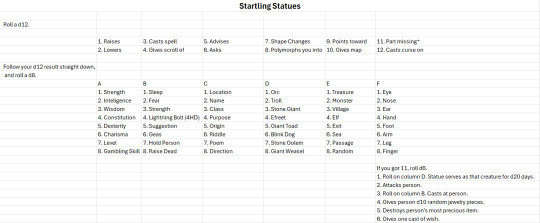
Tegal Manor wraps with some extra resurrection rules, in case you needed more realism in your magical revivification. I think I prefer it just working, thanks.
Modron (1977)

There's honestly a stunning lack of underwater content in RPGs, I think. Underwater is such a magical location, both experientially and in mythology. One of these days I will set an adventure in one of those sets from the old 1986 Journey to the West TV show, the underwater sea dragon palace ones? They're so fucking cool. Everything is better with underwater dragon palaces.

Right. Modron. Focus.
Modron is another one of those "straddling the line between module and setting book" situations, only much smaller than CSIO. The art all looks like Prince Valliant, which by that sentence alone either means you're going to love or hate it (I hate it). Our titular Modron is a goddess, but also a temple, but also a port town. We will deal with these in order.
Goddess Modron is a river goddess who was worshipped by the town and the temple. She is implied to be, kind of like wonder woman in a weird way? She has to exist underwater, or she dies in 6 rounds (so 6 minutes), which is pretty fucking lame but I too know the struggle of dry skin. She's a fertility goddess (who isn't) and she does d20 years of damage when she lovetaps you. Tragically, she is no longer worshipped in favor of Mitra. COWARDS! LOVE YOUR RIVER/SEA GODDESSES.
Modron's Temple is very, very briefly explained. Essentially, only the oldest people in town know how to find it, via the cellar of the tavern. It's completely underwater, and a lot of mermen hang out there. The head priestess can drain your water! Google says that one love tap would exhaust you, two would probably kill you, and three would definitely kill you. It's implied in this section that a JttW-style Triton Coral Kingdom is, in fact, hanging out off the shoreline somewhere.
Town Modron is your standard raided port town. There was once two gods worshiped here, then it got messed up by raiders and ECONOMICS and some light civil war. It's okay, ya boi Invincible Overlord is sending you a bailout, making him a better autocrat than most living politicians. Apparently they have a pet seamonster who serves the overlord directly? Awesome! We need more pet kaiju in the world.
The actual area-by-area is pretty blasé. The local rulers are varyingly competent (the king is competent but a huge sex pest), there's a guy who takes you on guided tours to, anywhere in the multiverse? Somehow the blacksmith has figured out how to rustproof armor, which will really piss off your rust monsters. The book makes a point to say that the jailor is a particular bastard, so Judge's Guild says ACAB? Unlikely but a very funny concept.
Tragically, we end our adventure without a map of the palace, the temple, the other temple, or anything. I don't believe this is the first supplement to contain Mitra as JG's most famous god (well, Mitra is a real-life god anyhow), but this is certainly the first adventure-ish module to feature him. Dark Tower is quite a ways away!

A poison coral table is, one of those things you would only ever see in early DND. That is so unbelievably specific. The book ends with many such cases, there's a pearl randomizer that doesn't include any fun magic effects or anything, merely linking to Supplement II. Boo!
So originally when writing this, I had intended that part 4 be a whole unit, but then I realized that I was going to have to include these semi-adventures in the roundup. So to my great shame, we will continue this later.
7 notes
·
View notes
Text
Scrap mechanic workshop cracked

Scrap mechanic workshop cracked cracked#
Scrap mechanic workshop cracked full version#
Scrap mechanic workshop cracked install#
Scrap mechanic workshop cracked download#
Always disable your anti virus before extracting the game to prevent it from deleting the crack files. Also, be sure to right click the exe and always select “Run as administrator” if you’re having problems saving the game. Look for a ‘HOW TO RUN GAME!!.txt’ file for more help. You need these programs for the game to run.
Scrap mechanic workshop cracked install#
If you get any missing dll errors, make sure to look for a _Redist or _CommonRedist folder and install directx, vcredist and all other programs in that folder. NOTICE: This game is already pre-installed for you, meaning you don’t have to install it.
Scrap mechanic workshop cracked full version#
It is the full version of the game. Don’t forget to run the game as administrator.
Scrap mechanic workshop cracked download#
Have fun and play! Make sure to run the game as administrator and if you get any missing dll errors, look for a Redist or _CommonRedist folder and install all the programs in the folder.Ĭlick the download button below to start Scrap Mechanic freeload with direct link.
Double click inside the Scrap Mechanic folder and run the exe application.
zip file and click on “Extract to 0.6.2.718.zip” (To do this you must have 7-Zip, which you can get here).
Once Scrap Mechanic is done downloading, right click the.
zip v nhp vo Extract to 0.5.1.659.zip ( lm iu. Sau khi hon tt qu trnh ti xung Scrap Mechanic, hy nhp chut phi vo tp. By gi hy qu trnh ti xung bt u v i n kt thc. Now let the download begin and wait for it to finish. Ch 5 giy v nhp vo nt ‘Download Now’ mu xanh lam.
Wait 5 seconds and click on the blue ‘download now’ button.
Click the Download button below and you should be redirected to UploadHaven.
You’re even able to team up with your friends to create amazing things together: in Scrap Mechanic, you’re the master creator of anything you can imagine! My mechanic thinks the interface computer module that turns the fans on.
Scrap mechanic workshop cracked cracked#
(*) This item isn't an unique drop, it just has increased chances to be found.Scrap Mechanic is an all-new creative sandbox game which drops you right into a world where you quite literally engineer your own adventures! Choose from the 100+ building parts you have at your disposal and create anything from crazy transforming vehicles to a house that moves. The 2008/2009 Infiniti G37 problem with the most reports is a cracked dashboard.(quantity of items received depends on the floor) Rare mobs in Labyrinth on Floors 25th and further **Note: Improvement items such as Glare Stone, Record Frames, and enhancement stones and hammers are more common/improved rank on higher floors.**Ģx Crafting material unique to this monster Treasure chests appear only in some dungeons and labyrinths. Very rare - it'll drop when you least expect it.Rare - probably need ten or more tries to get it.Uncommon - there's still a high probability to get it, but you should prepare a party to gather a reasonable amount of those.Common - most mobs drop them, every group should give you at least one of those.Bosses have slightly increased drop rate for rare items on higher floors. There are some items, which are shared by certain enemy types on every floor. Keep in mind that all drop rates stated below are NOT officially confirmed, I've written them based on my experience. I've divided their rarities into four ranks: Common, Uncommon, Rare and Very rare.Įvent drops are not listed, since these can be checked before participating an event by opening "Drop item" list from event page. Here are listed all items, which can be dropped by mobs on every floor existing in the game.

0 notes
Photo

Partway through undressing for bed Alexus hesitated, glancing at Amara. “Um. Are you okay with this? ‘Cause like... you, you said something earlier about your dude being like, not okay with like, non-purity and stuff? But it’s like, really hot? And I don’t wanna wear my shirt to bed.”
Amara shrugged. “The reason why I said the thing about purity is Arwen is a unicorn—or actually, he’s now ascended to an alicorn—and it’s just that traditionalistic thinking where like, unicorns and alicorns tend to like young beautiful females over males. Kind of like, an old history thing.” She dismissed the concern with a wave of a hand, then burbled on, “I dunno he would probably like you because you’re really funny and cool and I’ve been dying to braid your hair and—”
Alexus' face lit. “Oh hell yeah! Hell yeah, girl—get on it!”
“We can do fun buns!”
My half-elf fighter and my friend’s aasimar warlock are sharing a tent as we aimlessly wander out into the jungles of Chult in our budding D&D campaign. We talked about it a little bit out of character when I was originally buying the tent but last session I figured we ought to figure out the whole “she mentioned her patron doesn’t like guys but she’s sharing a tent with one” thing in-character as well.
And then she mentioned the hair braiding thing and I was like heck yes I have to draw this now so here we are.
Bonus:
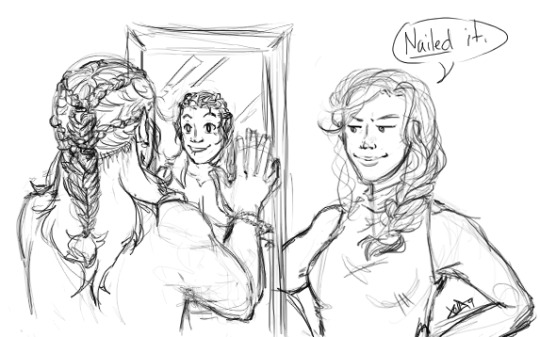
#xellart#dungeons and dragons#aasimar#half elf#alex#that's the biggest two person tent I've ever seen#also I'm reasonably sure that not only do I own the only tent#(or half of it since kattii technically owns half too)#but I'm the only person in our five person+NPC guide party with a bedroll#or other sort of sleeping apparatus#these idiots are sleeping on the jungle floor with no means of sheltering from the rain#(and it IS raining)#(I don't know if that was the DM being sadistic or if it's part of the module)#sketch line city
10 notes
·
View notes